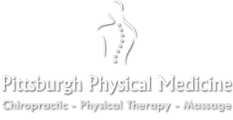Posture Correction in Pittsburgh PA

90% of patients in my practice have one thing in common; Constant computer use. Whether it is a job, hobby, cell phone, or just plain lying around. The top three conditions arising from these postures that start to develop are neck pain, back pain, and headaches in Pittsburgh PA. I explain these heavily on my website and when you are a patient. I teach how to correct these imbalances thoroughly when you become a patient.
Upper Crossed Syndrome In Pittsburgh PA is the biggest issue arising from sitting for long periods of time day after day.
Upper crossed syndrome is a postural imbalance that affects the upper body, particularly the neck, shoulders, and chest. It is caused by the weakening of some muscles and the tightness of others, leading to a rounded shoulder and forward head posture. This condition is common among people who spend long hours sitting in front of a computer, driving, or using a mobile device.
Understanding Upper Crossed Syndrome
Upper crossed syndrome is a common musculoskeletal disorder that affects people of all ages. It is a result of poor posture, which causes a muscle imbalance in the upper body. The muscles that are weakened include the deep neck flexors, lower trapezius, and serratus anterior. These muscles help to stabilize the neck, shoulders, and shoulder blades. The muscles that become tight and overactive include the upper trapezius, levator scapulae, and pectoralis major/minor. These muscles help to lift the shoulders and rotate the neck.
The imbalance in muscle strength leads to a postural imbalance that affects the upper body. The shoulders become rounded, and the head moves forward, resulting in a hunched posture. This condition can cause pain and discomfort in the neck, shoulders, and upper back. It can also cause headaches and reduced mobility in the upper body.
Symptoms of Upper Crossed Syndrome
The symptoms of Upper Crossed Syndrome can vary depending on the severity of the condition. Some of the common symptoms include:
- Neck pain and stiffness
- Shoulder pain and weakness
- Headaches
- Reduced range of motion in the neck and shoulders
- Tingling or numbness in the arms or hands
- Fatigue and muscle weakness
- Postural changes, such as a forward head posture and rounded shoulders
Relief from Upper Crossed Syndrome
The solution for Upper Crossed Syndrome involves a combination of exercises and lifestyle modifications. Here are some of the common options:
- Stretching exercises: Stretching exercises can help to reduce the tension in the tight muscles and improve the flexibility of the muscles. Some of the common stretching exercises include shoulder rolls, chest stretches, and neck stretches.
- Strengthening exercises: Strengthening exercises can help to strengthen the weak muscles and restore the muscle balance. Some of the common strengthening exercises include scapular retractions, wall angels, and chin tucks.
- Posture correction: Posture correction involves making lifestyle modifications to improve posture. This may include adjusting the workstation setup, using an ergonomic chair, and taking regular breaks to stretch and move around.
- Manual therapy: Manual therapy, such as massage and chiropractic adjustments, can help to relieve pain and tension in the affected muscles.
- Pain management: Pain management techniques, such as heat therapy, ice therapy, and over-the-counter pain medications, can help to alleviate pain and discomfort.
Prevention of Upper Crossed Syndrome
Prevention of Upper Crossed Syndrome involves maintaining good posture and adopting healthy lifestyle habits. Here are some tips to prevent upper crossed syndrome:
- Maintain good posture: Sit and stand up straight, with your shoulders relaxed and your head aligned with your spine.
- Take frequent breaks: Take frequent breaks from sitting or standing to stretch and move around.
- Exercise regularly: Exercise regularly to strengthen your muscles and improve your flexibility.
- Use ergonomic equipment: Use ergonomic chairs, desks, and other equipment to promote good posture.
- Be mindful of your posture: Be aware of your posture throughout the day and make adjustments as needed.
Conclusion
Upper crossed syndrome is a common postural imbalance that can cause pain and discomfort in the upper body. It is caused by a muscle imbalance that affects the neck, shoulders, and chest. The solution for Upper Crossed Syndrome involves a combination of exercises and lifestyle modifications.
Request An Appointment Today!
OFFICE HOURS
Monday
8:00am - 6:00pm
Tuesday
2:00pm - 6:00pm
Wednesday
8:00am - 6:00pm
Thursday
8:00am - 6:00pm
Friday
8:00am - 12:00pm
Saturday & Sunday
Closed
Pittsburgh Physical Medicine
5916 Penn Ave
Pittsburgh, PA 15206


